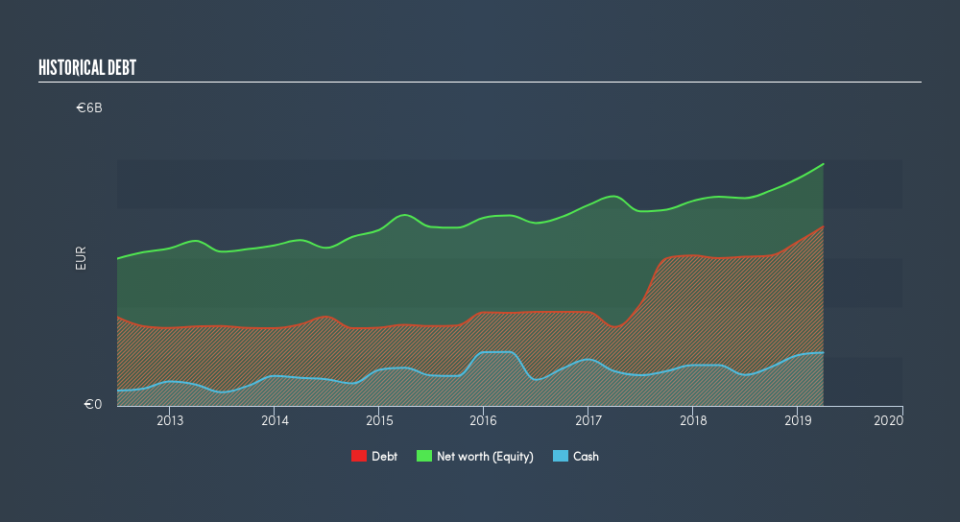Are Legrand SA's (EPA:LR) Interest Costs Too High?

Want to participate in a short research study? Help shape the future of investing tools and you could win a $250 gift card!
Legrand SA (EPA:LR), a large-cap worth €17b, comes to mind for investors seeking a strong and reliable stock investment. Doing business globally, large caps tend to have diversified revenue streams and attractive capital returns, making them desirable investments for risk-averse portfolios. However, the key to their continued success lies in its financial health. Today we will look at Legrand’s financial liquidity and debt levels, which are strong indicators for whether the company can weather economic downturns or fund strategic acquisitions for future growth. Remember this is a very top-level look that focuses exclusively on financial health, so I recommend a deeper analysis into LR here.
See our latest analysis for Legrand
LR’s Debt (And Cash Flows)
LR's debt levels surged from €3.0b to €3.6b over the last 12 months , which accounts for long term debt. With this rise in debt, the current cash and short-term investment levels stands at €1.1b , ready to be used for running the business. Additionally, LR has generated cash from operations of €921m during the same period of time, resulting in an operating cash to total debt ratio of 25%, signalling that LR’s current level of operating cash is high enough to cover debt.
Can LR pay its short-term liabilities?
At the current liabilities level of €1.8b, it seems that the business has maintained a safe level of current assets to meet its obligations, with the current ratio last standing at 1.69x. The current ratio is the number you get when you divide current assets by current liabilities. Generally, for Electrical companies, this is a reasonable ratio as there's enough of a cash buffer without holding too much capital in low return investments.
Is LR’s debt level acceptable?
With debt reaching 68% of equity, LR may be thought of as relatively highly levered. This isn’t surprising for large-caps, as equity can often be more expensive to issue than debt, plus interest payments are tax deductible. Since large-caps are seen as safer than their smaller constituents, they tend to enjoy lower cost of capital. We can check to see whether LR is able to meet its debt obligations by looking at the net interest coverage ratio. As a rule of thumb, a company should have earnings before interest and tax (EBIT) of at least three times the size of net interest. In LR's case, the ratio of 17.58x suggests that interest is amply covered. High interest coverage serves as an indication of the safety of a company, which highlights why many large organisations like LR are considered a risk-averse investment.
Next Steps:
LR’s high cash coverage means that, although its debt levels are high, the company is able to utilise its borrowings efficiently in order to generate cash flow. This may mean this is an optimal capital structure for the business, given that it is also meeting its short-term commitment. This is only a rough assessment of financial health, and I'm sure LR has company-specific issues impacting its capital structure decisions. I suggest you continue to research Legrand to get a more holistic view of the large-cap by looking at:
Future Outlook: What are well-informed industry analysts predicting for LR’s future growth? Take a look at our free research report of analyst consensus for LR’s outlook.
Valuation: What is LR worth today? Is the stock undervalued, even when its growth outlook is factored into its intrinsic value? The intrinsic value infographic in our free research report helps visualize whether LR is currently mispriced by the market.
Other High-Performing Stocks: Are there other stocks that provide better prospects with proven track records? Explore our free list of these great stocks here.
We aim to bring you long-term focused research analysis driven by fundamental data. Note that our analysis may not factor in the latest price-sensitive company announcements or qualitative material.
If you spot an error that warrants correction, please contact the editor at editorial-team@simplywallst.com. This article by Simply Wall St is general in nature. It does not constitute a recommendation to buy or sell any stock, and does not take account of your objectives, or your financial situation. Simply Wall St has no position in the stocks mentioned. Thank you for reading.

